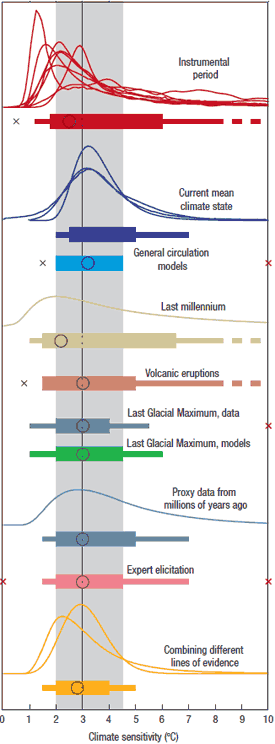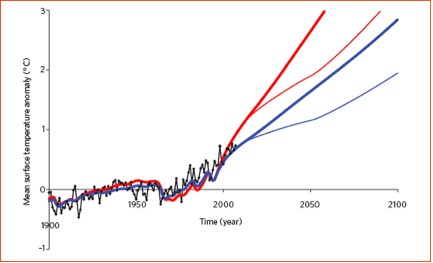How CO2 warming is driving climate
What the science says...
The Nature commentary by Penner et al. on which this argument is based actually says that on top of the global warming caused by carbon dioxide, other short-lived pollutants (such as methane and black carbon) cause an additional warming approximately 65% as much as CO2, and other short-lived pollutants (such as aerosols) also cause some cooling. However, claiming that CO2 has only caused 35% of global warming is a gross misinterpretation and misunderstanding of the paper.
Climate Myth...
CO2 only causes 35% of global warming
CO2 does not account for even a majority of the warming seen over the past century. If other species accounted for 65% of historical warming that leaves only 35% for carbon dioxide. (Doug Hoffman)
In August 2010, Nature published a commentary by Penner et al. which mainly focused on the uncertainty regarding the effect short-lived pollutants (such as aerosols and black carbon) have on the climate. As is often the case, many in the blogosphere misinterpreted and misunderstood the statements and conclusions in the commentary. Not surprisingly, the biggest misinterpretation related to the contribution of anthropogenic greenhouse gases to global warming. Below is the most misunderstood quote, with emphasis on the key word.
"Of the short-lived species, methane, tropospheric ozone and black carbon are key contributors to global warming, augmenting the radiative forcing of carbon dioxide by 65%. Others — such as sulphate, nitrate and organic aerosols — cause a negative radiative forcing, offsetting a fraction of the warming owing to carbon dioxide."
Numerous blogs have (mis)interpreted this statement to mean that carbon dioxide is only causing 35% as much global warming as previously believed. A more accurate reading of the quote is that certain short-lived pollutants cause warming in addition to carbon dioxide - quantitatively, approximately 65% as much warming as CO2. And certain other short-lived species cause a cooling effect which offsets some of this warming.
This is not a new conclusion. The IPCC puts the radiative forcing from CO2 at 1.66 W/m2, compared to the forcing from other greenhouse gases, black carbon, and tropospheric ozone at approximately 1.4 W/m2. Similarly, the negative forcing from aerosols is approximately -1.2 W/m2.

Figure 1: Radiative forcing estimates from the IPCC FAR
Thus if anything, the 65% figure is an underestimate of the contributions of short-lived pollutants to global warming, but this contribution does not change the 1.66 W/m2 radiative forcing from CO2 or the amount of global warming it has caused.
Much ado has also been made about another quote from the commentary:
"Warming over the past 100 years is consistent with high climate sensitivity to atmospheric carbon dioxide combined with a large cooling effect from short-lived aerosol pollutants, but it could equally be attributed to a low climate sensitivity coupled with a small effect from aerosols. These two possibilities lead to very different projections for future climate change."
This statement gets to the main point of the commentary - that there remains significant uncertainty regarding the effect of these short-lived pollutants on the global climate. However, estimates of the planetary climate sensitivity to increasing atmospheric CO2 and other radiative forcings are not solely based on the change in the mean global temperature over the past 100 years. In fact, the climate sensitivity parameter has been estimated through many different methods, including:
- climate models
- recent responses to large volcanic eruptions
- recent responses to solar cycles
- paleoclimate data
- data from the last Glacial Maximum
- and yes, data from the instrumental period
All of these different methods show strong agreement, overlapping in the IPCC climate sensitivity range of 2 to 4.5°C for a doubling of atmospheric CO2 (2xCO2).

Figure 2: Distributions and ranges for climate sensitivity from different lines of evidence. The circle indicates the most likely value. The thin colored bars indicate very likely value (more than 90% probability). The thicker colored bars indicate likely values (more than 66% probability). Dashed lines indicate no robust constraint on an upper bound. The IPCC likely range (2 to 4.5°C) and most likely value (3°C) are indicated by the vertical grey bar and black line, respectively (Knutti and Hegerl 2008)
Interestingly, Penner et al. find that whether the climate sensitivity parameter is on the low or high end, reducing anthropogenic emissions of the short-lived warming pollutants would achieve a significant reduction in global warming over the next 50-100 years. In the red lines in the Figure 3, they employ a climate model with a sensitivity of 5°C for 2xCO2, slightly outside the IPCC likely range. The blue line is a climate model with a sensitivity of 2°C for 2xCO2, on the lower end of the IPCC range. Note that even with the lower climate sensitivity, the model shows the planet warming 3°C by 2100 in this emissions scenario (see the figure caption for further details).

Figure 3: Global mean temperature measurements (black) and projections based on an IPCC scenario with high emissions (A2) for a climate sensitivity parameter of 5°C (upper red) and 2°C (upper blue). Linearly decreasing the total anthropogenic radiative forcing owing to methane, tropospheric ozone and black carbon — starting in 2010 and achieving pre-industrial levels by 2050 — results in significant near-term climate mitigation (lower blue and red curves) (Penner 2010)
Unfortunately, reducing the short-lived cooling pollutants such as aerosols would cause a warming effect of similar magnitude, and so CO2 remains the primary pollutant of concern. Coincidentally, a group of scientists from NASA GISS just published a paper in Science entitled Atmospheric CO2: Principle Control Knob Governing Earth's Temperature.
Although it is important to reduce the remaining climate uncertainties, such as the magnitude of the impacts of short-lived pollutants, it does not change the fact that CO2 is very likely the driving force behind the current global warming, or that if we double the amount of CO2 in the atmosphere from pre-industrial levels, the planet will likely warm in the range of 2 to 4.5°C.
Last updated on 13 August 2015 by dana1981. View Archives































 Arguments
Arguments





























As to CO2 controls water, it influences the amount of water vapour in the atmosphere because the warmer the air, the more water vapour it can hold. If you don't believe me, buy a hygrometer and watch relative humidity fall in winter and rise in summer.
[DB] There are literally thousands of threads here at SkS and none are closed (and I'm not sure if anyone has counted them all). Some may be dormant or currently inactive, but fresh comments posted anywhere will not be ignored.
Since you were directed to specific, more appropriate threads where your questions would be better placed, why not follow those pointers & get the reolution to your questions you seek?
As for the Control Knob, have you watched this yet?
[Dikran Marsupial] If you wanted to know what I meant by top of the atmosphere, a good place to have started would be to read the real climate article I linked for your benefit. It explains how the greenhouse effect actually operates, and most of us here would benefit from reading it (I know I did).
Temperature does cause CO2 to rise (all things being otherwise equal) because a warm ocean can hold less CO2. However, in the current situation, all things are not equal; specifically anthropogenic emissions have cause atmospheric CO2 levels to rise, and higher partial pressure of CO2 in the atmosphere causes increased absorbtion by the oceans (and by the biosphere - it is plant food). This dominates the increase in ocean emissions due to the warming of the oceans to date. The oceans are a net carbon sink, not a source.
There were many ways temperature or other climate features could influence the carbon dioxide level one way or another. Perhaps variations of temperature and of weather patterns caused land vegetation to release extra CO2, or take it up... perhaps the oceans were involved through massive changes in their circulation or ice cover... or through changes in their CO2-absorbing plankton, which would bloom or decline insofar as they were fertilized by minerals, which reached them from dusty winds, rivers, and ocean upwelling, all of which could change with the climate... or perhaps there were still more complicated and obscure effects. Into the 21st century, scientists kept finding new ways that warming would push more of the gas into the atmosphere. As one of them remarked, "it is difficult to explain the demise of the ice sheets without the added heating from CO2 ... this gas has killed ice sheets in the past and may do so again.